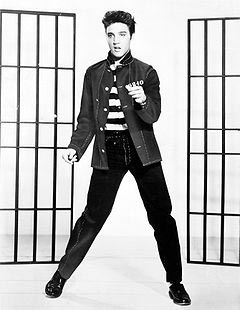


Main article: Rock and roll
Rock and roll evolved in the United States in the late 1940s and early 1950s, and quickly spread to much of the rest of the world. Its immediate origins lay in a mixing together of various popular musical genres of the time, including rhythm and blues, gospel music, and country and western.[2] In 1951, Cleveland, Ohio disc jockey Alan Freed began playing rhythm and blues music for a multi-racial audience, and is credited with first using the phrase "rock and roll" to describe the music.[2] There is much debate as to what should be considered the first rock & roll record. One leading contender is "Rocket 88" by Jackie Brenston and his Delta Cats (in fact, Ike Turner and his band The Kings of Rhythm), recorded by Sam Phillips for Sun Records in 1951.[3] Four years later, Bill Haley's "Rock Around the Clock" (1955) became the first rock and roll song to top Billboard magazine's main sales and airplay charts, and opened the door worldwide for this new wave of popular culture.[4] Rolling Stone magazine argued in 2004 that "That's All Right (Mama)" (1954), Elvis Presley's first single for Sun Records in Memphis, was the first rock and roll record.[5], but, at the same time, Big Joe Turner's "Shake, Rattle & Roll", later covered by Haley, was already at the top of the Billboard R&B charts. Other artists with early rock and roll hits included Chuck Berry, Bo Diddley, Fats Domino, Little Richard, Jerry Lee Lewis, and Gene Vincent.[3] The 1950s saw the growth in popularity of the electric guitar, and the development of a specifically rock and roll style of playing through such exponents as Berry, Link Wray, and Scotty Moore.[6] It also saw major developments in recording technology such as multitrack recording developed by Les Paul, the electronic treatment of sound by such innovators as Joe Meek, and the Wall of Sound productions of Phil Spector. All these developments were important influences on later rock music.[7] The social effects of rock and roll were worldwide and massive. Far beyond simply a musical style, rock and roll influenced lifestyles, fashion, attitudes, and language.[8] In addition, rock and roll may have helped the cause of the civil rights movement because both African American teens and white American teens enjoyed the music.[9] Motown played an important role in the racial integration of popular music, as it was the first record label owned by an African American to primarily feature African-American artists who achieved crossover success. In the early 1960s, Motown and its soul-based subsidiaries were the most successful proponents of what came to be known as The Motown Sound, a style of soul music with a distinct pop influence. From 1961 to 1971, Motown had 110 top 10 hits, and artists such as Stevie Wonder, Marvin Gaye, The Supremes, The Four Tops, and The Jackson 5, were all signed to Motown labels. All of these acts have been inducted into the Rock and Roll Hall of Fame.